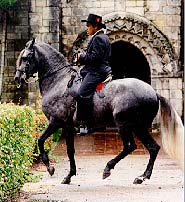Paso Fino
N/A
Mon, 25th November, 2024 - 10:01 pm GMT
Sponsor Ads:

Alternative Name
N/ABasic Info
The head of the Paso Fino should be refined and in good proportion to the body of the horse, neither extremely small nor large with the preferred profile being straight. Eyes are large and well spaced, very expressive and alert, and should not show excessive white around the edges. Ears are comparatively short, set close, and curved inward at the tips. The lips should be firm and the nostrils large and dilatable. Jaws are defined but not extreme. The impression should be of a well-shaped, alert, and intelligent face. The neck should be gracefully arched, medium in length and set on at an angle to allow high carriage, breaking at the poll. Throat latch should be refined and well-defined. Shoulders are sloping into the withers with great depth through the heart. Chest is moderate in width. The withers are defined but not pronounced and slope smoothly into the back. The midsection is moderate in length with a well-sprung rib cage. the topline should be proportionately shorter than the underline. The back should be strong and muscled. The midsection should join the forehand and the hindquarters so as to give the horse a pleasing, proportioned appearance. Regarding the hindquarters, the croup is slightly sloping with rounded hips, broad loins, and strong hocks. The tail is carried gracefully when horse is in motion. The legs are straight with refined bones and strong, well defined tendons and broad, long fore-arms with shorter cannons. Thigh and gaskins are strong and muscled, but not exaggerated. Standing slightly under in the rear is typical. Pasterns are sloping and medium in length. Bones are straight, sound and flat, and joints are strong and well defined. The hooves are well rounded, proportionate in size, and do not show excessive heel. Mane, tail and forelock should be as long, full and luxurious as nature can provide. No artificial additions or alterations are allowed. A bridle path not exceeding 4" is acceptable. Size ranges from 13 to 15.2 hands with 13.3 to 14.2 being the most typical. Weight ranges from 700 to 1100 lbs. Full size may not be attained until the fifth year.
Health
N/AHabitat
N/ABehavior
The disposition of the Paso Fino is marked by an extremely willing horse that truly seems to enjoy human companionship and strives to please. Spirited and responsive under tack; sensible and gentle at handOrigin
Western HemisphereHistory
The Paso Fino has a proud past and is one of the oldest native breeds of horse in the Western Hemisphere. In 1492, Columbus discovered a continent without horses. On his second voyage from Spain, he brought a select group of mares and stallions from the provinces of Andalusia and Cordela, and settled them at Santo Domingo. These horses were a mixture of Barb, Andalusian and Spanish Jennet. The Spanish Jennet not only possessed an extremely comfortable saddle gait, but also was able to pass the gait on to its offspring. The result of the blending of these horses was horses with an incredibly smooth gait, which would evolve into the Paso Fino breed. These horses were the foundation stock for the remount stations of the Conquistadors. As Spanish settlers came to the New World, they brought more Spanish horses. During the nearly 500 years that Paso Fino Horses have been selectively bred and perfected in the Western Hemisphere, they have been called upon to perform a diverse role, first in the conquest of, and then in the exploration and development of the AmericasCommon Foods
grassSponsor Ads:
We learn from experience that men never learn anything from experience. -- Oscar Wilde
Paso Fino
Coded by: BGID® | ALL RIGHTS RESERVED Copyright © 2000-2024
Disclaimer | Privacy | Report Errors / Contact | Credits


 Homosexual behavior stems from the mind or genetics?
Homosexual behavior stems from the mind or genetics?  The Best Text Adventure You Will Ever Play! The official site:
The Best Text Adventure You Will Ever Play! The official site:  Why haven't we as a collective earth met with aliens yet?
Why haven't we as a collective earth met with aliens yet?  World EcoSystem - Biodiversity Changes - Who is on board and who isn
World EcoSystem - Biodiversity Changes - Who is on board and who isn  Mouthwash - Mouthrinse - Mouth Sores - Healing Infections - Gingivitis
Mouthwash - Mouthrinse - Mouth Sores - Healing Infections - Gingivitis  Treatment for Depression
Treatment for Depression  Ultra radical and violent Islamist group that even rivals Al Qaeda
Ultra radical and violent Islamist group that even rivals Al Qaeda  An idea to have teachers who want to carry guns to school undergo some level of police training will be left up to local school districts and police departments.
An idea to have teachers who want to carry guns to school undergo some level of police training will be left up to local school districts and police departments.